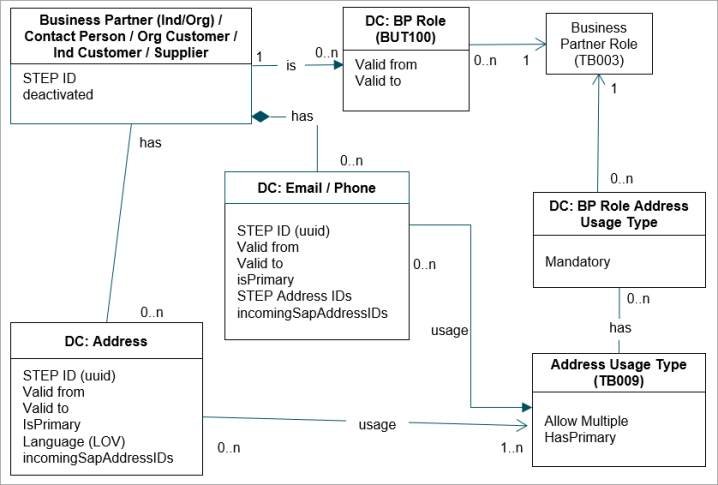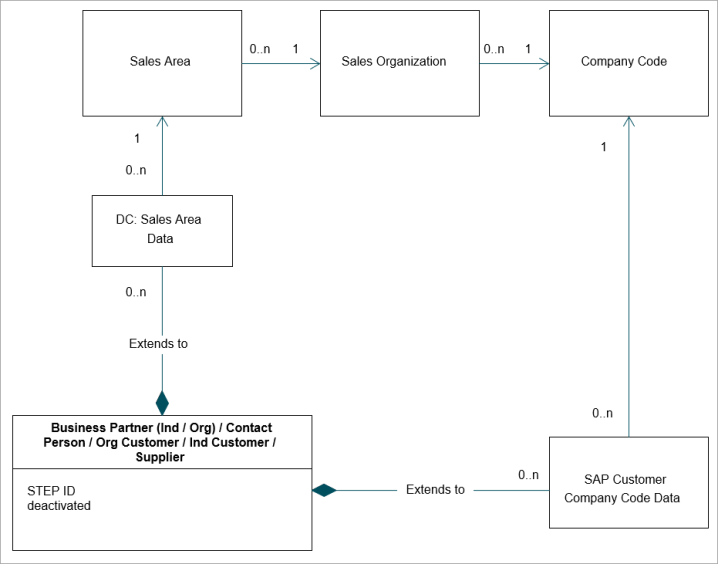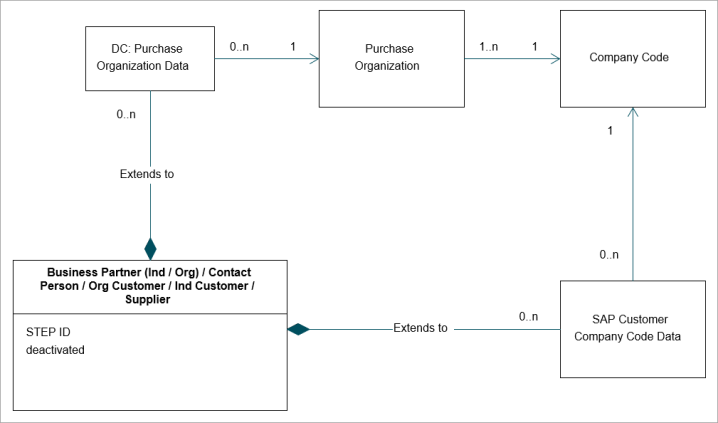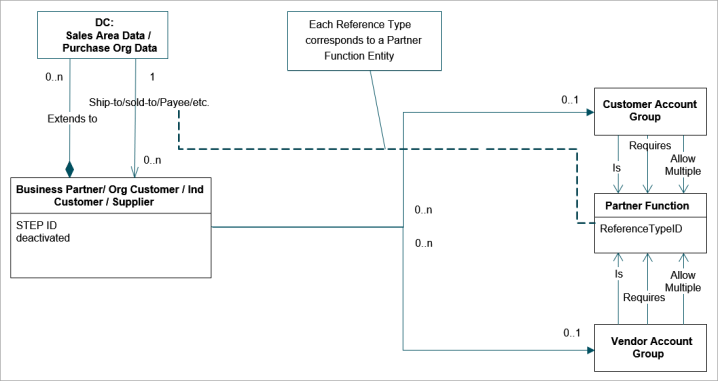A variety of constraints exist and are illustrated in the logical model diagram in the SAP Business Partners and Enterprise Structure Definitions topic. The constraint types are outlined in the following sections.
Uniqueness Constraints
The following are uniqueness constraints as defined:
-
Unique by ID
-
Business Partner Role
-
Customer Account Group
-
Vendor Account Group
-
Company Code
-
Sales Organization
-
Distribution Channel
-
Purchase Organization
-
Business Partner
-
Business Partner Role Exclusion Group
-
Business Partner Relation Category
-
Business Partner Grouping
-
Address Usage Type
-
-
Sales Area is unique by the combination of sales organization, distribution channel and division.
-
Data Container Sales Area Data is unique within each business partner by sales area.
-
Data Container Customer- and Vendor Company Code Data are unique within each business partner by company code.
-
Data Container Purchase Organization Data is unique within each business partner by purchase organization.
-
Data Container BP Role is unique within each business partner by business partner role.
-
Data Container Source Record Status is unique within each business partner by source system and source record ID.
-
Data Container SAP Address Source Record relation is unique within each business partner by STEP address ID and SAP address UUID.
Business Partner Role Constraints
One BP can reference multiple BP Roles. The Roles of a BP determine constraints for BP Relations. Refer to the 'Business Partner Relationships' section of the SAP Business Partners and Enterprise Structure Definitions topic.
The Customer- and Vendor Account Group of the BP determines constraints for Partner Function relations in Sales Area- and Purchasing Organization Data of the Business Partner. Refer to the 'Partner Functions' section of the SAP Business Partners and Enterprise Structure Definitions topic.
A BP references a BP Role within a validity period.
At a given point in time, the Roles of a Business Partner must not be in the same Business Partner Role Exclusion Group.
Business Partner Relationship Constraints
To the extent possible, it is recommended to use the basic configuration of reference types and data container types to control the constraints of Business Partner (BP) Relationships.
However, the following constraints may require additional logic, which can be implemented in business rules.
Note: When additional constraints are required beyond those mentioned below, manage them by extending the data model for BP Relationship Categories and using STEP business rules to govern the constraints.
BP Role Validity on BP Relationships
When the setup of object types for BP entities (refer to the 'Business Partner versus Customer and Supplier Object Types' section of the SAP Business Partners and Enterprise Structure Definitions topic) results in one BP entity having the object type of a BP entity is not sufficient to determine if it is a valid source and/or target of a particular BP Relationship reference type.
The BP Role Entity and its valid from / valid to references to BP Relationship Categories should be used to express this additional constraint and a STEP business rule should be used to govern this constraint.
Validity Periods
In SAP, a BP Relationship may have a validity period.
These are the validity period constraints:
-
0 / no value: No validity period constraint
-
1: Record must have no gaps, no overlap
-
2: Record may have gaps but no overlap
-
4: Record exists at least once from minimum to maximum
This should be managed in STEP as a Time Constraint Attribute (attribute ID=SAP-TIMDP) on the BP Relationship Category Entity and STEP business rules should be used to govern the constraint.
Address, Email, and Phone Usage Constraints
Address Usage Types define which usages an address, email, and/or phone number that a BP, at a given point in time, in a specified language:
-
can have multiples of
-
has a primary of
This is expressed by the Address, Email and Phone Data Containers having references to Address Usage Types. One address, email, or phone may have multiple usages.
The Roles of a BP determines which Address Usages it:
-
can have now and in the future
-
must have now and in the future
This is expressed by Address Usage Type Entities being related to BP Roles.
Use STEP business rules to govern such constraints.

Sales Area Data Constraints
In SAP, a Sales Area defines the Sales Organization and Distribution Channel that a Division uses to sell products. Therefore, Sales Areas are comprised of distribution channel, division, and sales organization.
In STEP, Sales Areas are referenced from the BP object by way of a reference (ID= SAPCustomerSalesAreaDataSalesArea) from the Sales Area data container (ID= SAPCustomerSalesAreaData).
A BP may contain zero-to-many Sales Area data containers (ID=SAPCustomerSalesAreaData).
A BP may only have Sales Area Data if the corresponding Company Code Data is present such that the Sales Area must be associated to a Sales Organization that is associated to a Company Code for which the BP has Company Code Data.

Purchase Organization Data Constraints
A BP may contain zero-to-many Purchasing Organization Data Containers (ID=SAPPurchasingOrganizationData).
A BP may only have Purchase Organization Data if the corresponding Company Code Data is present such that the Purchase Organization (also called a 'purchasing organization') must be associated to a Company Code for which the Business Partner has Company Code Data.

Partner Functions Constraints
A Customer has exactly one Customer Account Group and a Supplier has exactly one Vendor Account Group. An account group has one-to-many valid partner functions. Not all customers and vendors can act in all partner functions.

Since a BP has a given account group, it must also have one or multiple Partner Function relations.
-
Valid Partner Functions - Not all customers or suppliers can act in all partner functions. The Account Group defines one-to-many valid Partner Function relations for a Customer / Supplier.
-
Mandatory Partner Functions - For each Sales Area Data or Purchasing Organization Data, the Account Group defines the required Partner Function relations for a Customer / Supplier.
-
Allow Multiple of a Partner Function - For each Sales Area Data or Purchasing Organization Data, the Account Group defines which Partner Function relations allow multiple Customers / Suppliers.
Common Distribution Channel and Division Constraints
To avoid redundant sales area master data across distribution channels and divisions, distribution channels and division may have a common 'parent,' which is logically resolved into what may be termed as 'common sales areas.' This concept means that sales areas associated with a particular distribution channel and division may have a common distribution channel and common division in another sales area within the same sales organization. This hierarchy is nested.
-
If a customer is active in a sales area that is common for other sales areas, this customer cannot have master data in the other sales areas.
-
If a customer is active in a sales area, a user is not allowed to activate that customer in the sales area's common sales areas.